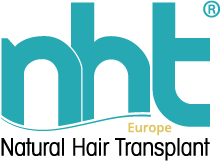Medical Treatments
Medical Treatments at
NHT EUROPE
In this section, we offer you an overview of medical treatments.
But before starting a treatment, a diagnosis of your condition must be made. This step is essential before any therapeutic approach can be developed.
To diagnose a condition, several tests must be carried out.
First of all, we need to obtain genetic information about your family history, but we also need to check your scalp carefully for the absence of dermatological diseases that could be responsible for your hair loss.
We may also carry out biological examinations in order to eliminate vitamin or mineral deficiencies, or to highlight hormonal disorders.
And finally, we may perform a DNA analysis.
DNA testing
This DNA analysis provides important information, and allows us to better understand the main biological mechanisms causing hair loss.
The laboratory will inform us about the molecules that will be the most effective. This analysis is very interesting, because it allows us to have a greater therapeutic effectiveness, by using lotions containing more effective molecules and with much less allergic reactions.
In 2 years, we have treated a large number of patients with very few side effects, which are only slight skin irritations.
Since the introduction of this analysis, conventional treatments with finasteride and minoxidil are much less frequently recommended.
Growth factor treatment
This treatment is mainly represented by PRP (Platelet Rich Plasma), but other factors are available.
This treatment consists of using the growth factors contained in platelets. It is an autologous treatment, as the treatment starts with a small amount of blood being taken.
This sample is then centrifuged to separate the red blood cells, plasma and platelets. It is in the platelets that many growth factors are found, which are then reinjected into the scalp, with or without local anaesthetic.
This treatment is completely autologous and therefore free of harmful side effects. It can be used for the preservation of grafts during hair transplant procedures.
Nano fat graft
Initially used to improve scars, this procedure also improves the outcome of a hair transplant.
Scars can occur for very different reasons. After an accident or surgery, they sometimes remain large and visible. The same goes for burns, or after certain inflammatory conditions (lichen planus pilaris) where scars can spread all over the head.
An implantation of your own hair covers the scars and allows you to regain your well-being.
Recent scientific papers (ISHRS Congress October 2020, International Society of Hair Restoration Surgery) also report significant improvement in hair after a disappointing transplant result.
We are undoubtedly at the beginning of a new therapeutic concept for baldness and these procedures will certainly become more widespread in the near future.
At our NHT Europe centre, hair implants on scar tissue are among the most frequently performed procedures.
Hormonal treatments
The role of androgenic hormones has long been recognized in the development of baldness, whether in men or women going through menopause.
Testosterone is converted into dihydrotestosterone, DHT, by 5-alpha reductase enzymes, of which there are 2 types (type 1 and type 2). The transformation can be blocked by inhibitors of these enzymes, finasteride or dutasteride which blocks the 2 types of these enzymes (finasteride blocks only one, type 2).
For information, finasteride is now available as a lotion from some laboratories. This topical application seems to cause far fewer side effects on male sexual function, due to much lower rate of transmission to the bloodstream.
Photobiomodulation by led or laser
The LED photobiomodulation technique is a technique that causes stimulation of follicular cells through low energy radiation.
Treatment of the scalp using this technique promotes hair growth, limits hair loss and finally improves hair quality thanks to the light.
The cells absorb light, the energy production process is stimulated, which leads to the improvement in the function of the treated cells: stimulation of microcirculation, reduction of inflammation, improvement of cell metabolism and protein synthesis.
This technique can be carried out either with LEDs or laser diodes of which there are many models on the market.
This technique is non-invasive, painless, has no side effects, the light rays cover the entire scalp and provide effective and inexpensive results.
European studies and an American experiment approved by the Food and Drug Administration (FDA) performed on these laser treatments show that hair loss is stopped in 95% of cases and hair regrowth is stimulated in 55% of cases. Patients who used this treatment said that their hair was thicker, had more volume, luster while noting regrowth to varying degrees.
Food supplements
After a hair transplant, it is not essential to take food supplements to strengthen the transplanted hair. However, dietary supplements can help improve the outcome. Also, some of them containing sulphur amino acids or trace elements in tablets can be useful for 1 to 3 months to maintain the hair still present on the top of the head.
In this section, we invite you to learn more about dietary supplements and the general importance of eating well for healthy hair.
At our NHT Europe clinic, located in Avignon, we offer our patients the opportunity to have their DNA sampled. This possibility of studying your genome allows us to learn about your general state of health and therefore your deficiencies. Based on the results, we will be able to offer you effective food supplements without side effects.
The essential information
These medical treatments have made great progress. They can stop the development of baldness.
In many cases, hair regrowth is observed.
Medical treatments are particularly important, especially for women.
performed at NHT EUROPE







